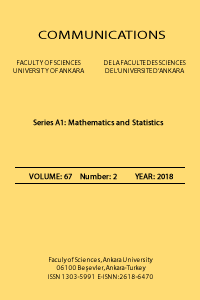Analysis and optimal control of an HIV model with logistic growth and infected cells in eclipse phase
HIV infection, logistic growth treatment, stability, optimal control,
___
- Chesney, M.A., et al, Adherence: a necessity for successful HIV combination therapy, 13, (1999), S271-8.
- Pankavich, S., The Effects of Latent Infection on the Dynamics of HIV, Differential Equations and Dynamical Systems 24(3), (2016), 281-303.
- Allali, K., Harroudi, S. and Torres, D. F. M. , Analysis and optimal control of an intracellular delayed HIV model with CTL immune response, Math. Comput. Sci 12(2), (2018) , 111-127.
- Rocha, D., Silva, C. J. and Torres, D. F. M., Stability and Optimal Control of a Delayed HIV Model, Math. Methods Appl. Sci 41(6), (2018), 2251-2260.
- Allali, K., Tabit, Y. and Harroudi, S., On HIV Model with Adaptive Immune Response, Two Saturated Rates and Therapy, textitMathematical Modelling of Natural Phenomena 12(5), (2017), 1-14.
- Nowak, M.A., Bonhoeffer, S., Shaw, G.M., May, R.M., Anti-viral drug treatment: Dynamics of resistance in free virus and infected cell populations, Journal of theoretical biology 184(2), (1997), 203-217.
- Allali, K., Danane, J. and Kuang, Y., Global Analysis for an HIV Infection Model with CTL Immune Response and Infected Cells in Eclipse Phase, Applied Sciences 7(8), (2017), 861.
- Rong, L., Gilchrist, M. A., Feng, Z. and Perelson, A. S., Modeling within-host HIV-1 dynamics and the evolution of drug resistance: trade-offs between viral enzyme function and drug susceptibility, textitJournal of Theoretical biology 247(4), (2007), 804-818.
- Rong, L. and Perelson, A. S., Asymmetric division of activated latently infected cells may explain the decay kinetics of the HIV-1 latent reservoir and intermittent viral blips, Mathematical biosciences 217(1), (2009), 77-87.
- Buonomo, B. and Vargas-De-León, C., Global stability for an HIV-1 infection model including an eclipse stage of infected cells, textitJournal of Mathematical Analysis and Applications 385(2), (2012), 709-720.
- Sun, Q., Min, L. and Kuang, Y., Global stability of infection-free state and endemic infection state of a modified human immunodeficiency virus infection model, IET systems biology 9(3), (2015), 95-103.
- Selinger, C. and Katze, M. G., Mathematical models of viral latency, Current opinion in virology 3(4), (2013), 402-407. Orellana : Orellana, J.M., Optimal drug scheduling for HIV therapy efficiency improvement, Biomedical Signal Processing and Control 6(4), ( 2011), 379-386.
- Wang, Y., Zhou, Y., Wu, J. and Heffernan, J., Oscillatory viral dynamics in a delayed HIV pathogenesis model, Mathematical Biosciences 219(2), (2009), 104-112.
- Wang, L., Li and M. Y., Mathematical analysis of the global dynamics of a model for HIV infection of CD4+ T cells, textitMathematical Biosciences 200(1), (2006), 44-57.
- Culshaw, R. V., and Ruan, S., A delay-differential equation model of HIV infection of CD4+ T-cells, Mathematical biosciences 165(1), (2000), 27-39.
- Smith, H. L. and De Leenheer, P., Virus dynamics: A global analysis, SIAM Journal on Applied Mathematics 63(4), (2003), 1313-1327.
- Van den Driessche, P., and Watmough, J., Reproduction numbers and sub-threshold endemic equilibria for compartmental models of disease transmission, Mathematical biosciences 180(1-2), (2002), 29-48.
- Fleming, W. H. and Rishel, R. W., Deterministic and stochastic optimal control (Vol. 1), Springer Science and Business Media, (2012).
- Lukes, D. L., Differential equations, ser, Mathematics in Science and Engineering. London: Academic Press Inc.[Harcourt Brace Jovanovich Publishers] 162, (1982).
- Pontryagin, L. S., Boltyanskii, V. G., Gamkrelidze, R. V. and Mishchenko, E. F., The mathematical theory of optimal processes, (1962).
- Lai, X. and Zou, X., Modeling cell-to-cell spread of HIV-1 with logistic target cell growth, Journal of Mathematical Analysis and Applications 426(1), (2015), 563-584.
- Jones, L. E. and Perelson, A. S., Transient viremia, plasma viral load, and reservoir replenishment in HIV-infected patients on antiretroviral therapy, Journal of acquired immune deficiency syndromes (1999) 45(5), (2007), 483.
- Meskaf, A., Allali, K. and Tabit, Y., Optimal control of a delayed hepatitis B viral infection model with cytotoxic T-lymphocyte and antibody responses, International Journal of Dynamics and Control 5(3), (2017), 893-902.
- ISSN: 1303-5991
- Yayın Aralığı: Yılda 4 Sayı
- Başlangıç: 1948
- Yayıncı: Ankara Üniversitesi
Gülay OGUZ, İlhan ICEN, M. Habil GURSOY
G. NANDİNİ, M. VENKATACHALAM, S. GOWRİ
Complete system of invariants of vectors for isometry group in n-dımensional unitary space
D. Vamshee KRİSHNA, D. SHALİNİ
Numerical Solutions of Time Fractional Korteweg--de Vries Equation and Its Stability Analysis
Derivatives of Sasakian metric ^{S}g on Cotangent Bundle
